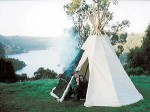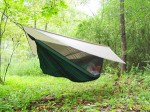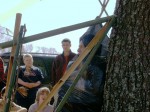Shelters provide safety and comfort from heat and cold, and well as from physical threats like the sun, rain, snow, sand or animals. Shelters should be found or constructed away from potentially dangerous areas such as flood zones, lightning strike zones, avalanche areas, and on pathways. While there should generally be insulation, be sure there is adequate ventilation as well. If you don’t carry provisions for this purpose, you’d be surprised what materials at hand can do in a pinch. The following shelters may open your eyes to some possibilities.











i am glad i noticed this site… this stuff is really helpful
Thanks for the info. I’m glad to find this site. This will all be important stuff for us to know sooner than we think I’m afraid. Soooo helpful!
I REALLY APPRECIATE ALL THE INFO ON THIS SITE. PPL NEED TO LEARN AS MANY INNOVATIVE SURVIVAL TECHNIQUES AS POSSIBLE. BEING PREPARED IS ESSENTIAL FOR UPCOMING SURVIVAL. GOOD LUCK EVERYONE
Won’t the trashbag shelter get wet inside due to condensation from the breath & from it being wet on the outside? Doesn’t there have to be some spacers, so air can circulate between the bag & the clothes, so the condensation doesn’t soak the person? How many hours have you tried this bag out in, in the rain & in the cold? Does it really work?
The trashbag shelter is intended for emergency situations and not as a standard shelter. Condensation could be a slight problem but would certainly be better than becoming drenched in rainfall, and it helps to capture body heat. I had a friend who used this method on a biking trip when he got lost on a trail at nightfall.
For the hammock I recommend (because I lived in one for few monthes while building my house) a Eagles Nest Outfitters (ENO) hammock there so compact, light, comfortable, durable, easy to clean , and livable (I still use it for my bed) they are great for backpacking, camping, survival and they have so many accessories to go with them you can look them up on
ENO website
http://www.eaglesnestoutfittersinc.com/
(I am just recommending the from my experience I am in no way legally affiliated with them in any manner and this is just a personal recommendation)
Don’t know about sitting by a tree in rainstorm. Lightning could strike.